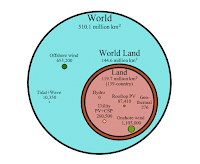- Replace 80% of business-as-usual power by 2030, and 100% by 2050
- Reduce power consumption by 42.5% because of electricity’s better work:energy ratio, efficiency, and lack of mining needed
- Create 24.3 million more jobs than lost
- Eliminate 3.5 million premature air pollution deaths per year and save $23 trillion (7.6% of GDP) in air pollution health costs per year by 2050 (for comparison: the World Bank estimated in 2016 that air pollution in 2013 killed 5.5 million people, with non-health care costs of over $5 trillion)
- Save $28.5 trillion per year in avoided climate change costs by potentially keeping global warming 1.5°C below pre-industrial levels
- Reduce war by creating energy-independent countries
- Decentralize energy production, thereby reducing power outages, terrorism threats to energy installations, and energy poverty
His road map to a 100% renewable energy future uses existing generator technologies, along with existing electrical transportation, heating/cooling, and industrial devices and appliances. Electricity storage is done using existing storage technologies—Concentrated Solar Power (CSP) with storage, pumped hydroelectric storage, and existing heat/cold storage technologies (water, ice, and rocks). No stationary storage batteries, biomass, nuclear power, carbon capture, or natural gas are required. No new dams would be needed, but existing dams would by made more efficient. Aircraft flying less than 600 km would be electric, and those flying longer distances would be powered by hydrogen fuel cells. He modeled the seasonal and daily variation in solar energy and wind power in the 139 countries, with storage, and was able to show that the power grid was stable—the load on the grid matched the electricity supply. The 2.5 million wind turbines required would cause approximately a 0.6% reduction in world’s average wind speed, which he argued should not cause major disturbances to the weather. Dr. Jacobson acknowledged that political obstacles would make his plan difficult to implement, but stressed that a solution to global warming is technically and economically feasible. A detailed discussion of his plan is here.
Read more at How to Save $23 Trillion Per Year: 100% Renewable Energy for the World


No comments:
Post a Comment